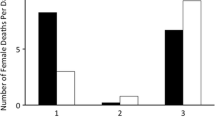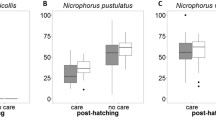Abstract
Regulation of brood size in a biparental burying beetle, Nicrophorus tomentosusWeber, was studied by providing pairs with one of two sizes of mouse carcasses in the laboratory. For a given carcass size, there was an inverse relationship between number and mass offspring in a brood. The requirement for regulation was that brood size was adjusted such that mean mass of individual larvae was constant for carcasses of different size. Brood size was regulated if parents were present but regulation did not occur if parents were removed prior to hatching of larvae. Pairs bred in quick succession on two carcasses raised fewer than the regulated number of young in the second reproductive attempt. Reasons for regulation of brood size in this genus are discussed.
Similar content being viewed by others
References
Bartlett, J. (1987). Filial cannibalism in burying beetles.Behav. Ecol. Sociobiol 21: 179–183.
Bartlett, J.,and Ashworth, C. M. (1988). Brood size and fitness inNicrophorus vespilloides (Coleoptera: Silphidae).Behav. Ecol. Sociobiol. 22: 429–434.
Brockelman, W. Y. (1975). Competition, the fitness of offspring, and optimal clutch size.Am. Nat. 109: 677–699.
Cowan, D. P. (1981). Parental investment in two solitary wasps,Ancistrocerus adiabatus andEuodynerus foraminatus (Eumenidae: Hymenoptera).Behav. Ecol. Sociobiol. 9: 95–102.
Easton, C. (1979).The Ecology of Burying Beetles (Nicrophorus, Coleoptera, Silphidae), Unpublished Ph.D. thesis, University of Glasgow, Glasgow.
Fabre, J. H. (1949). The burying beetle. In de Mattos, A. T. (ed. and translator),The Insect World of J. Henri Fabre, Dodd, Mead, New York, pp. 232–258.
Gill, D. E. (1974). Intrinsic rates of increase, saturation density, and competitive ability II. The evolution of competitive ability.Am. Nat. 108: 103–116.
Halffter, G., Anduaga, S., and Huerta, C. (1983). Nidification desNicrophorus. Bull. Soc. Entomol. F88: 648–666.
Hogstedt, G. (1980). Evolution of clutch size in birds: Adaptive variation in relation to territory quality.Science 210: 1148–1150.
Kozol, A. J., Scott, M. P., and Traniello, J. F. A. (1988). Natural history of a declining species,Nicrophorus americanus, the American burying beetle.Psyche 95: 167–176.
Lloyd, D. G. (1987). Selection of offspring size at independence and other size-versus-number strategies.Am. Nat. 129: 800–817.
Milne, L. J., and Milne, M. (1976). The social behavior of burying beetles.Sci. Am. 235: 84–89.
Morris, D. W. (1985). Natural selection for reproductive optima.Oikos 45: 290–292.
Müller, J. K. (1987). Replacement of a lost clutch: A strategy for optimal resource utilization inNecrophorus vespilloides (Coleoptera: Silphidae).Ethology 76: 74–80.
Müller, J. K., Eggert, A. K., and Dressel, J. (1989). Intraspecific brood parasitism in the burying beetle,Necrophorus vespilloides, (Coleoptera: Silphidae).Anim. Behav. (in press).
Pianka, E. R. (1976). Natural selection of optimal reproductive tactics.Am. Zool. 16: 755–784.
Pukowski, E. (1933). Öekologische Untersuchungen anNecrophorus F.Z. Morph. Öekol. Tiere. 27: 518–586.
Scott, M. P. (1990). Brood guarding and the evolution of male parental care in burying beetles.Behav. Ecol. Sociobiol. 26: 31–39.
Scott, M. P., and Traniello, J. F. A. (1987). Behavioural cues trigger ovarian development in the burying beetle,Nicrophorus tomentosus. J. Insect Physiol.33: 693–696.
Scott, M. P., and Traniello, J. F. A. (1990). Behavioural and ecological correlates of male and female parental care and reproductive success in burying beetles (Nicrophorus spp.).Anim. Behav. 39: 274–283.
Smith, C. C., and Fretwell, S. D. (1974). The optimal balance between size and number of offspring.Am. Nat. 108: 499–506.
Strickler, K. (1982). Parental investment per offspring by a specialist bee: Does it change seasonally?Evolution 36: 1098–1100.
Trivers, R. L. (1974). Parent-offspring conflict.Am. Zool. 14: 249–264.
Trumbo, S. T. (1987).The Ecology of Parental Care in Burying Beetles (Silphidae: Nicrophorus). Unpublished Ph.D. thesis, University of North Carolina, Chapel Hill.
Trumbo, S. T. (1989) Interference competition among burying beetles (Silphidae:Nicrophorus). Ecol. Entomol. (in press).
Wilson, D. S., and Fudge, J. (1984). Burying beetles: Intraspecific interactions and reproductive success in the field.Ecol. Entomol. 9: 195–203.
Wilson, D. S., Knollenberg, W. G., and Fudge, J. (1984). Species packing and temperature dependent competition among burying beetles (Silphidae,Nicrophorus). Ecol. Entomol.9: 205–216.
Winkler, D. W., and Wallin, K. (1987). Offspring size and number: A life history model linking effort per offspring and total effort.Am. Nat. 129: 708–720.
Zeh, D. W., and Smith, R. L. (1985). Paternal investment by terrestrial arthropods.Am. Zool. 25: 785–805.
Author information
Authors and Affiliations
Rights and permissions
About this article
Cite this article
Trumbo, S.T. Regulation of brood size in a burying beetle,Nicrophorus tomentosus (Silphidae). J Insect Behav 3, 491–500 (1990). https://doi.org/10.1007/BF01052013
Accepted:
Issue Date:
DOI: https://doi.org/10.1007/BF01052013




